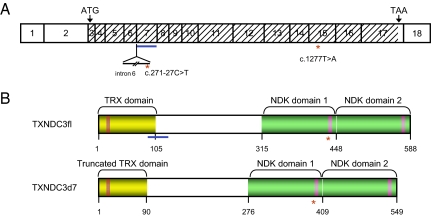GENETICS. For the article “A common variant in combination with a nonsense mutation in a member of the thioredoxin family causes primary ciliary dyskinesia,” by Bénédicte Duriez, Philippe Duquesnoy, Estelle Escudier, Anne-Marie Bridoux, Denise Escalier, Isabelle Rayet, Elisabeth Marcos, Anne-Marie Vojtek, Jean-François Bercher, and Serge Amselem, which appeared in issue 9, February 27, 2007, of Proc Natl Acad Sci USA (104:3336–3341; first published February 20, 2007; 10.1073/pnas.0611405104), Fig. 1 appeared incorrectly, due to a printer's error. The online version has been corrected. The corrected figure and its legend appear below.
Fig. 1.
The human TXNDC3 gene and related products. (A) TXNDC3 cDNA structure showing the location of the exons drawn to scale. The translation start and stop codons are labeled with ATG and TAA, respectively. The translated region is hashed. Exon 7 is underlined in blue, and intron 6 is shown as a thin line below exons 6 and 7. The red asterisks mark the locations of the c.271–27C>T and c.1277T>A nucleotide variations, located in intron 6 and exon 15, respectively. (B) Structure of the TXNDC3 isoforms: the TXNDC3fl isoform (Upper) and the TXNDC3d7 isoform (Lower). The thioredoxin (TRX) domain and the two NDK domains are shown in yellow and green, respectively. Within the TRX domain, the active site (GCPC) is shown by an orange box, and, within the NDK domains, the putative NDP kinase active sites are shown by pink boxes. The location of the region encoded by exon 7 is underlined in blue. The location of the p.Leu426X mutation is shown by a red asterisk.



